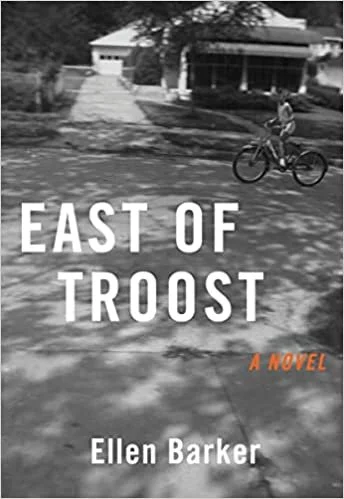East of Troost by Ellen Barker
Summary
Have you ever imagined moving back to your childhood home? In East of Troost, Ellen Barker’s narrator does just that: after a major setback, she returns to Kansas City, buys the house she grew up in, and digs into her new reality. The neighborhood is not what it was back in the day. It looks different, the demographics are different, and it even sounds different – an expressway has plowed through the neighborhood just a block away. And finds that the area once described as “oh, near Swope Park” now has a name: “east of Troost,” a place most white people won’t go anymore.
But the unnamed narrator of this first-person novel goes there anyway. She moves in because it’s what she can afford and because she’s desperate for some sense of home. It’s a struggle, getting the house back in shape and figuring out how she fits in the changed neighborhood. But with a wise next-door neighbor and her stalwart German Shepherd, she makes progress while dealing with mice, falling plaster, a break-in, tornado warnings.
Place is important in this story. Revisiting locations of her childhood sometimes helps with grounding her in her new reality, and sometimes leaves her feeling more lost than ever. Some places delight and others make her question her decision to return to this city. The city has moved on, though, and so does she.
By turns amusing and heart-wrenching, this debut novel takes you inside Kansas City through the eyes of a native who has returned and now sees it with different eyes.
Book Settings: Kansas City, MO
Troost Avenue: The red line between “White” Kansas City on the west side and “Black” Kansas City on the east.
Bruce Watkins Drive: The expressway built through the neighborhood east of Troost.
6900 Blocks of Chestnut, South Benton, and Agnes: The immediate neighborhood, where the narrator and her closest neighbors live.
31st and Prospect: This intersection was the site of rioting after the assassination of Martin Luther King, Jr. Rebuilt in a more modern style, it now seems out of place.
Midland Hardware: It’s called Midtown Hardware in the book. It’s the go-to place for all the home repair in East of Troost. Owned by Nick Gadino since 1976, the store has changed very little in the intervening years.
Church’s Fried Chicken: Across the street from Midland Hardware, the closest carryout and a KC fast-food favorite.
Country Club Plaza: A Spanish-style shopping district from the 1920s known for high-end shopping and eats.
Topsy’s: The narrator stops here to grab cinnamon popcorn.
The Classic Cup: The narrator grabs lunch with Angie here.
Saint Louis Church: The narrator’s childhood parish church. She tiptoes back in and finds it strange and familiar and it becomes a refuge.
Hogan High School: Now a public academy, the building still stands even if the owner is new.
The Landing: A mall across the street from Hogan, where she and her friends used to hang out after school. All the stores are different, but her needs are different now too.
Research Hospital: Josie is taken there after an early-morning fall. Its presence ensures medical care in a part of the city with few stores and services.
Habitat for Humanity’s ReStore: There are several of these stores in Greater Kansas City; the narrator mostly seeks out the closest one and talks them into setting up a “FReeStore” for marginal donations like old water pipes, now hopelessly clogged, that she is happy to use to stake tomatoes.
Saint James Church: A stop here provides a connection with long-dead parents, who were married in this lovely place.
Nelson-Atkins Museum of Art: A weekday trip here with a surprise: since 1998, it has made admission free to all. The collection is beyond what she could have imagined.
Kansas City Public Library: In the heart of downtown KC, the library is an architectural masterpiece with marble columns and bronze doors.
Kansas City Zoo: A world-class, 200-acre zoo that is a showpiece in the middle of the 1800-acre Swope Park, all of it heart-warmingly east of Troost.
Loose Park: A popular park, large and beautiful, site of many friends’ weddings – and now, a west-of-Troost spot.
Fairyland Park: Long gone and now the site of a middle school, Alphapoint, and (relevant to this story), the KC Police Department Metro Patrol.
Reviews
“Fuses an engrossing plot with an exploration of social issues.”
- Publishers Weekly
“Ellen Barker has written a book that should give women of a certain age and privilege a lot to think about. What happens when you try to go home again, and what can you learn in the process?”
—Beth Lisick, author of Edie on the Green Screen and New York Times bestseller Everyone into the Pool
“A quiet, candid recalibration of memories against a changed landscape, Ellen Barker’s East of Troost is a journey both touching and powerful, reminding us how gentle courage and faith in humanity can overcome the fear of what divides.”
—Lorraine Devon Wilke, author of The Alchemy of Noise

